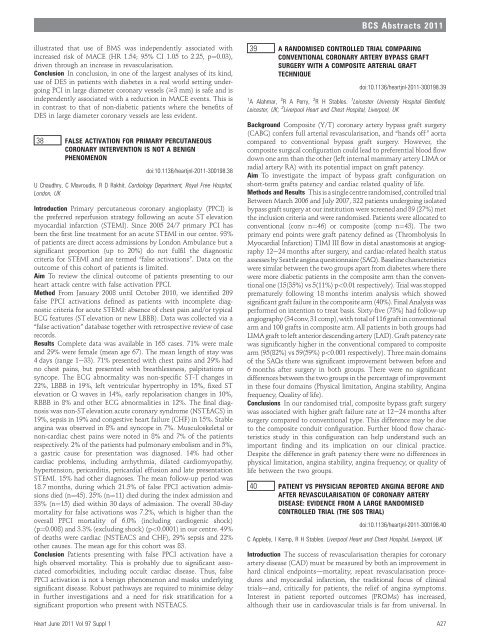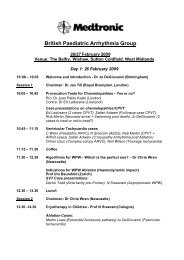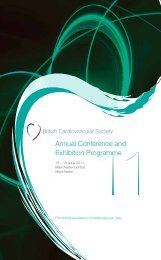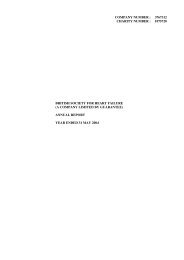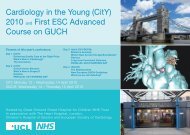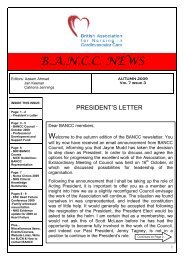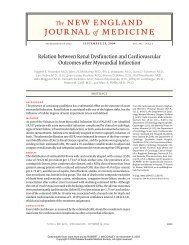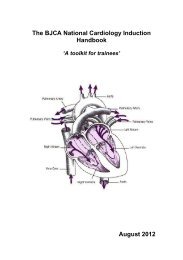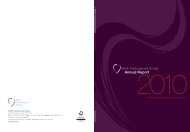Full Supplement - British Cardiovascular Society
Full Supplement - British Cardiovascular Society
Full Supplement - British Cardiovascular Society
Create successful ePaper yourself
Turn your PDF publications into a flip-book with our unique Google optimized e-Paper software.
BCS Abstracts 2011<br />
illustrated that use of BMS was independently associated with<br />
increased risk of MACE (HR 1.54; 95% CI 1.05 to 2.25, p¼0.03),<br />
driven through an increase in revascularisation.<br />
Conclusion In conclusion, in one of the largest analyses of its kind,<br />
use of DES in patients with diabetes in a real world setting undergoing<br />
PCI in large diameter coronary vessels ($3 mm) is safe and is<br />
independently associated with a reduction in MACE events. This is<br />
in contrast to that of non-diabetic patients where the benefits of<br />
DES in large diameter coronary vessels are less evident.<br />
38 FALSE ACTIVATION FOR PRIMARY PERCUTANEOUS<br />
CORONARY INTERVENTION IS NOT A BENIGN<br />
PHENOMENON<br />
doi:10.1136/heartjnl-2011-300198.38<br />
U Chaudhry, C Mavroudis, R D Rakhit. Cardiology Department, Royal Free Hospital,<br />
London, UK<br />
Introduction Primary percutaneous coronary angioplasty (PPCI) is<br />
the preferred reperfusion strategy following an acute ST elevation<br />
myocardial infarction (STEMI). Since 2005 24/7 primary PCI has<br />
been the first line treatment for an acute STEMI in our centre. 93%<br />
of patients are direct access admissions by London Ambulance but a<br />
significant proportion (up to 20%) do not fulfil the diagnostic<br />
criteria for STEMI and are termed “false activations”. Data on the<br />
outcome of this cohort of patients is limited.<br />
Aim To review the clinical outcome of patients presenting to our<br />
heart attack centre with false activation PPCI.<br />
Method From January 2008 until October 2010, we identified 209<br />
false PPCI activations defined as patients with incomplete diagnostic<br />
criteria for acute STEMI: absence of chest pain and/or typical<br />
ECG features (ST elevation or new LBBB). Data was collected via a<br />
“false activation” database together with retrospective review of case<br />
records.<br />
Results Complete data was available in 165 cases. 71% were male<br />
and 29% were female (mean age 67). The mean length of stay was<br />
4 days (range 1e33). 71% presented with chest pains and 29% had<br />
no chest pains, but presented with breathlessness, palpitations or<br />
syncope. The ECG abnormality was non-specific ST-T changes in<br />
22%, LBBB in 19%, left ventricular hypertrophy in 15%, fixed ST<br />
elevation or Q waves in 14%, early repolarisation changes in 10%,<br />
RBBB in 8% and other ECG abnormalities in 12%. The final diagnosis<br />
was non-STelevation acute coronary syndrome (NSTEACS) in<br />
19%, sepsis in 19% and congestive heart failure (CHF) in 15%. Stable<br />
angina was observed in 8% and syncope in 7%. Musculoskeletal or<br />
non-cardiac chest pains were noted in 8% and 7% of the patients<br />
respectively. 2% of the patients had pulmonary embolism and in 5%,<br />
a gastric cause for presentation was diagnosed. 14% had other<br />
cardiac problems, including arrhythmia, dilated cardiomyopathy,<br />
hypertension, pericarditis, pericardial effusion and late presentation<br />
STEMI. 15% had other diagnoses. The mean follow-up period was<br />
18.7 months, during which 21.5% of false PPCI activation admissions<br />
died (n¼45). 25% (n¼11) died during the index admission and<br />
33% (n¼15) died within 30 days of admission. The overall 30-day<br />
mortality for false activations was 7.2%, which is higher than the<br />
overall PPCI mortality of 6.0% (including cardiogenic shock)<br />
(p¼0.008) and 3.3% (excluding shock) (p


